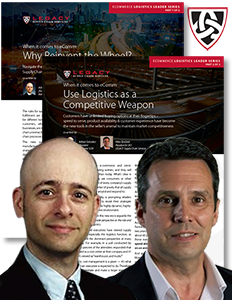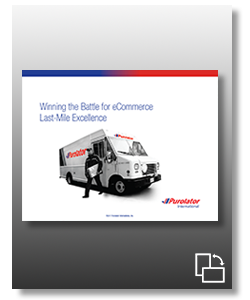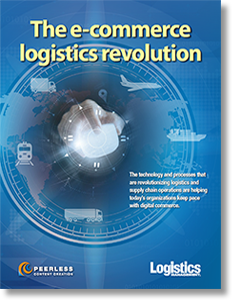All Major Modes of Transportation Involved in the Evolving Ecommerce Enabled Supply Chain

While last mile carriers receive much of the attention, the traditional modal heavyweights are in charge of connecting the growing web of facilities that enable e-commerce, today, all modes, as well as freight intermediaries, must be poised for growth and flexible enough to keep evolving.
As Amazon continues its inexorable march toward distribution and order-fulfillment dominance, logistics managers are examining the opportunities all modal players are promising as they build out their e-commerce supply chains.
As a consequence, the nation’s industrial transportation networks have been largely transformed.
According to the CBRE Group, the world’s largest commercial real estate services firm, there’s been a proliferation of warehouses and distribution centers (DCs) spanning 1 million square feet or larger across the nation.
And while “last mile” carriers receive most of the attention these days, the traditional modal heavyweights are in charge of connecting this ever-growing web of facilities.
“The massive warehouses and DCs have sprouted from Southern California to Philadelphia, clustering around metro areas that provide the combination of road, rail, air and sea access that e-commerce users covet,” says David Egan, CBRE’s head of industrial and logistics research in the Americas.
To date, 117 such facilities were built across the United States from 2010 to 2016 for a total of 141.2 million square feet - a significant increase from the 99 facilities built between 2003 and 2009, according to CBRE data.
The markets in which the most big-box construction occurred over the past six years are led by Philadelphia, California’s Inland Empire and Dallas/Fort Worth. By way of the forecast, CBRE says the Inland Empire, Chicago, Philadelphia, and Atlanta lead the busiest markets for on-going construction of 1 million-square-foot DCs. Across the 10 busiest U.S. markets for this type of construction, 29 such facilities are now underway.
Egan maintains that this trend foretells several different things. “The proliferation of big-box facilities underscores the rapid growth of e-commerce, because these mega-facilities serve as the backbone of retailers’ fulfillment networks, distributing goods across multi-state regions,” he says.
Furthermore, says Egan, developers prefer to build these big boxes in industrial-powerhouse “metros” that offer the best combination of exceptional transportation access and close proximity to big populations favored by e-commerce users. “While massive warehouses aren’t purely a phenomenon of e-commerce, the two are closely related,” he says.
“E-commerce users typically need two to three times the amount of warehouse and distribution space that traditional users do.”
That’s mostly because e-commerce fulfillment requires more inventory, labor, and automation. According to Lexi Russell, a senior research analyst with CBRE, the strongest trend to watch now is “build-to-suit,” which customizes warehousing for trucks, rail, and intermodal service.
“The dimensions of the warehouse are determined by the client,” she says, “to maximize traffic driven by e-commerce in the new demand cycle.”
New Air Cargo Hubs
The impact on air cargo operations is already being felt by upstarts like Greater Cincinnati/Northern Kentucky International Airport (CVG), which will now serve as Amazon’s centralized hub for its newly-launched Prime Air Cargo service.
“Amazon advised us of several factors important to them, including site availability and infrastructure,” says Candace McGraw, CEO of CVG. “CVG owns more than 7,500 acres of property, four runways, plenty of taxiways, and we’re a cost-effective airport. To top it off, we’re committed to investing $5 million in infrastructure improvements that will assist the airport and the overall project,” adds McGraw.
Meanwhile, it appears that the “middle-mile” of e-commerce will also be served by established hubs like Dallas Fort Worth International (DFW) Airport. This international cargo gateway recently began installing a cold chain facility that will be operated by AirLogistix USA.
Expected to be operational this summer, the new transfer facility will give DFW the ability to precisely control warehousing temperatures for shipments of pharmaceuticals, flowers, and fresh foods. John Ackerman, executive vice president of global strategy and development at DFW, calls it “a natural choice” for the AirLogistix facility, given the airport’s location in the center of the United States.
Aaron Ahlburn, senior vice president and director of research for the industrial property consultancy Jones Lang LaSalle, concurs, noting that DFW enjoys a certain geographical advantage. He says location - as well as market timing - is key. “Obviously, there are broad industrial and logistics real estate implications as e-commerce supply chains are perfected,” he says.
The Middleman in the Mix
According to Brandon Fried, executive director of the Air Forwarders Association, implications for today’s freight intermediaries due to the double-digit growth of e-commerce are equally complex - regardless of mode.
“Freight forwarders have traditionally been focused on the business-to-business supply chains, but are now making some inroads into business to consumer deliveries,” says Fried. “We see this in many of our members delivering appliances, large electronics, and other substantial-sized goods into private homes.”
Because forwarders are traditionally “asset light,” they can be quite nimble in adapting to changing e-commerce market needs, adds Fried.
“We are seeing this now in the online ordering environment where forwarders are supplying distribution centers, either the actual brick-and-mortar retail outlets or e-commerce fulfillment facilities with a wide range of shipments from suppliers to maintain their inventory,” says Fried.
Indeed, building customized solutions for complex supply chain challenges is where freight forwarders excel, Fried contends. Unlike the “old days” of the 20th Century, forwarders are less mode-centric and more focused on actual solutions where the form of transportation is only part of the overall logistics scheme.
“The freight forwarder role in e-commerce tends to support suppliers moving industrial goods - both finished and in actual components - which may or may not end up in the consumer goods supply chain,” he says.
But while transport infrastructure and warehousing are moving at warp speed, the learning curve, as well as the pace of adoption among forwarders, is being brought into question by air cargo industry experts.
Dr. Michael Hanke, founder and managing director of SkaiBlu, an e-commerce consultancy assisting clients in the aviation industry, says that recent analysis of the top 50 airfreight forwarders found them unprepared for “digitized” commerce.
“Across the board, results were not encouraging and many forwarders don’t appear to be fit for a competitive cyberspace presence,” says Hanke. “Many sites suffer from slow speed, are not optimized for mobile devices, lack information on their handling of digital customer data including information on cybersecurity measures.”
According to Hanke, most forwarder websites are poorly designed and have a small, if any, presence on social media platforms. “This is just a snapshot of the findings,” he says. “Essentially, if any of these companies want to be relevant for their customers, these e-basics have to be addressed soon,” he says.
Intermodal Imperatives
The Intermodal Association of North America (IANA) examined the rise of e-commerce and the future of expedited intermodal at its last annual conference, and will likely address the issue in greater detail throughout the year.
“E-commerce and associated services have fueled ever-increasing service expectations on the part of shippers,” says Derrick Broome, vice president of intermodal for C.A.T. Global, a multimodal service provider. As an IANA board member, he also notes that the mission for surface mode transport providers will now be to determine how the marketplace requirement is evolving under increased pressure in the demand cycle.
“For intermodal to remain in the game, intermediaries are going to have to move light years ahead in the way they process information,” says Broome. “This not only speeds up business but creates a closer bond with the shipper as transparency is enhanced.”
Logistics terminals that facilitate the transfer of goods between rail and motor carrier are now being increasingly co-located in high-density business districts with facilities that can process a range of commodities and distribution centers for finished, containerized goods, notes Bill Rennicke, a partner at the global management consultancy Oliver Wyman.
“Compressing distances in these ways could drive the development of new regional services, including blended trains - with a mix of bulk commodity, automotive and containerized traffic - and more direct point-to-point services,” says Renicke.
Waterborne Worries
Shippers are rightly concerned about the wave of ocean carrier consolidation, but they should also consider the “digital divide” keeping some players out of the e-commerce marketplace.
To date, the most significant news in this regard surfaced last January when global container shipping giant Maersk announced that it will partner with Alibaba - a Chinese e-commerce provider. This endeavor will enable ocean shippers to book space on Maersk vessels through Alibaba’s booking service called OneTouch,
According to John Fay, CEO of INTTRA, a leading provider of e-commerce services for the ocean freight industry, that gap may be widening. “The main impact of consumer-driven e-commerce on ocean shipping is not on deployments and schedules, but rather shippers’ needs for more efficient logistics management,” he says.
Fay’s company recently announced that it generated 16% growth in 2016 over 2015 in container orders, which include bookings, shipping instructions and shipping orders. According to Container Trade Statistics, INTTRA processed 38.5 million container orders on its platform, while containership sailings in the industry rose by just 3% in 2016.
“We played a significant role in 2016 as the rate of technology and digitization accelerated rapidly in the ocean industry,” says Fay. “We believe that digitization is now indispensable.”
NavisWorld, a biannual conference to help port terminal operators optimize the movement of containers with the use of advanced technology, also focused on e-commerce during its 2017 conference.
“While the main impact of e-commerce to date has been around last-mile logistics and warehouses, it’s interesting to think how e-commerce can link back to what’s happening in the terminal and port,” says Andy Barrons, senior vice president for Navis.
According to Barrons, the new warehousing infrastructure and downstream processes need to be reinforced with accurate and near-real-time information flows from the upstream container movement from vessel arrival through to container availability and yard management that feeds the gate and rail process.
“Terminals and ports will see greater demand for providing visibility and predictability to container moves for logistics providers and shippers,” adds Barrons. “This, in turn, will drive more automation of processes.”
Read: Industry Experts Discuss Technology Trends & Solutions for Efficient Ecommerce Logistics
Related White Papers
Ecommerce Logistics Leader Series New!
Co-written by Adrian Gonzalez and Mike Glodziak, this ecommerce logistics leader series describes how you can get to market faster, by leveraging your existing network, resources, and relationships to their fullest potential as well as how you can use logistics as a competitive weapon. Download Now!
3 SEKO Logistics eCommerce Case Studies
Providing end-to-end supply chain solutions, enabling eCommerce stores, and freeing up management to focus on creativity, SEKO Logistics addresses the supply chain and logistics needs of London's Portobello Road MOU company, the iconic Lulu brand, and Escalade Sports. Download Now!
The Pain of Packing in an E-Commerce World
For any business with a B2C component, the warehouse has changed dramatically over the last few years…many retailers are closing or scaling back their brick and mortar shops in favor of increasing their direct to consumer business. Download Now!
Six Benefits of Adding Regional Carriers to Your Delivery Network New!
In this white paper, you’ll find tips on what to expect from regional carriers and how you can use them to build an elastic fulfillment network that helps control costs while adapting your services to your customers’ changing delivery preferences. Download Now!
Winning the Battle for Ecommerce Last-Mile Excellence
Last-mile delivery is the most important – and the most expensive – part of the logistics process, accounting for an estimated 28 percent of overall transportation spend. Download Now!
Improving Packaging: The Cost of Shipping Air is Going Up
Retailers and Manufacturers that insist on using inefficient and sloppy packaging methods - oversized boxes, inefficient packaging, poorly constructed palletized contents - are paying for their mistakes in sharply higher freight rates. Download Now!
The Ecommerce Logistics Revolution New!
In this special issue, the editorial staff of Logistics Management has compiled feature stories that encapsulate the software, technology, and processes that are helping today’s retail and manufacturing professionals exceed ever-increasing customer demands - whether in B2B or direct to consumers. Download Now!
More Ecommerce Resources
Article Topics
LEGACY Supply Chain Services News & Resources
Outsourcing eCommerce Fulfillment to a 3PL Rapidly Improve the Performance of Your Warehouse Logistics 20 Warehouse & Distribution Center Best Practices for Your Supply Chain Warehouse Contingency Planning Template 7 Last Mile Logistics Delivery & Ecommerce Trends You Don’t Want to Overlook Increase Inventory Visibility across Your Supply Chain and Optimize Omni-Channel Fulfillment Omni-Channel Logistics Leaders: Top 5 Inventory Insights More LEGACY Supply Chain ServicesLatest in Transportation
Baltimore Bridge Collapse: Impact on Freight Navigating Amazon Logistics’ Growth Shakes Up Shipping Industry in 2023 Nissan Channels Tesla With Its Latest Manufacturing Process Why are Diesel Prices Climbing Back Over $4 a Gallon? Luxury Car Brands in Limbo After Chinese Company Violates Labor Laws The Three Biggest Challenges Facing Shippers and Carriers in 2024 Supply Chain Stability Index: “Tremendous Improvement” in 2023 More TransportationAbout the Author

























